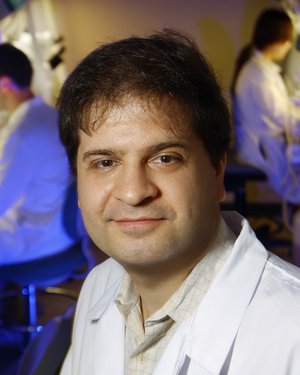Elias Zambidis | Using Stem Cells to Study Cancer
Background
Dr. Zambidis is Associate Professor of Oncology and Pediatrics at the Johns Hopkins University School of Medicine, and a member of the Johns Hopkins Kimmel Cancer Center. Dr. Zambidis’ clinical expertise is in the treatment of disorders of the immune system, histiocytic disorders, hematologic malignancies, blood and bone marrow transplantation (BMT), and regenerative medicine. His research interest focuses on advancing our understanding of pluripotent stem cells– the ‘master’ stem cells that can generate any new cell or tissue that the body needs to repair itself. Dr. Zambidis earned his M.D./Ph.D. in the Medical Scientist Training Program at the University of Rochester, Rochester, N.Y. He completed his Pediatrics Residency in the Department of Pediatrics, Washington University, St. Louis, Missouri, and his clinical/research fellowships in Pediatric Hematology/Oncology at the Johns Hopkins Hospital and the National Cancer Institute at the NIH. Dr. Zambidis has been interested in the biology of stem cells since he came to Johns Hopkins, in 2001. As a Pediatric Hematology/Oncology fellow, he was one of the very first Hopkins investigators to work with human embryonic stem cells (hESCs), beginning shortly after they were made available to the biomedical research community, in 2002. Dr. Zambidis was awarded the first NIH K08 Clinician-Scientist Training Award specifically investigating the therapeutic potential of human pluripotent stem cells (2004). After joining the Hopkins faculty, in 2005, he developed an experimental model of the early formation process of human blood and blood vessels using human pluripotent stem cells.
The Zambidis laboratory at the Johns Hopkins Institute for Cell Engineering focuses on understanding the developmental biology of human hemato-vascular and human pluripotent stem cells. More recently, his group completed studies on highly efficient methods for generating nonintegrated, human induced pluripotent stem cell (hiPSC) lines from myeloid progenitors. His group has developed novel hiPSC-based vascular therapies for retinopathies, and more recently derived a new class of human pluripotent stem cells in a naïve ground state with new functionalities with even greater potency and stronger regenerative capacities. As a BMT physician-scientist, his long-term goal is to use hESC, hiPSC, and related pluripotent stem cell technologies to not only treat severe degenerative diseases, but also to elucidate the biological nature of cancer and aging.
